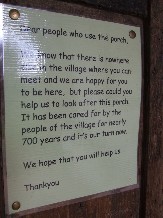| |
|
St
Michael, Flordon
 |
|
The
churches come thick and fast in this area to the
south of Norwich. The parishes are tiny, the
churches small and unlikely to bother compilers
of lists of England's Thousand Best Churches and
nonsense like that. John Betjeman once observed
that this part of Norfolk has the greatest
concentration of medieval buildings of anywhere
north of the Alps, and that is probably about
right. Flordon is too close to Norwich not
to feel suburban, and at first I was put off by
the bungalows and lap fencing which line the path
up to the church. But as you step out into the
graveyard, ignoring the tiresome, noisy attack
dog in the adjacent garden (whatever possesses
people?) you find yourself in a beautiful,
ancient space, a gently rising summit that must
have been a significant place in pre-Christian
times. Here, in early March, there were still
plenty of snowdrops in flower, and the low sun
lit up the elegant, slightly ramshackle length of
St Michael.
|
This was a
round-towered church once, like most around here, but the
Victorians replaced the fallen tower with a red brick
wall and a bellcote. The porch is handsome, and obviously
popular with the local 'yoof', because a sign on the door
said Dear People who use this porch, we know that
there is nowhere in the village where you can meet and we
are happy for you to be here. But please could you help
us to look after this porch. It has been cared for by the
people of the village for 700 years and it is our turn
now. We hope that you will help us. There you are, I
thought, the hand of charity, an act of living witness
and a history lesson, all in one.
And St
Michael is a perfect example of what a village church
should be. You step inside to a feeling of rural
continuity, a sympathetic Victorian restoration
overlaying the touchstones of the more distant past, the
war memorials a reminder of more recent pain and grief.
There's an image of St Peter in the east window, possibly
18th century, and some other bits with it which must all
have been collected from a continental monastery or
church by an antiquarian.
One
curiosity is the rather perfunctory early 20th century
rood. All that survives is the crucifix in the middle;
the figures of the Blessed Virgin and St John which
Mortlock saw here and commented upon in the 1980s, are
now gone. You can still see their fixings. Probably, they
were stolen, but it did occur to me to wonder if they had
actually been removed by the parish. The temper of
churches around here is very low, and protestant
sentiment might have led to the banishment of such
idolatrous figures of Saints. In which case, this would
have been one of the very last examples of puritan
iconoclasm in all East Anglia.
We came
here on a Saturday, and so we found the church open. If
we had come on a weekday, we would have needed to find a
key, but in this undistinguished village, the relatively
unimportant church of St Michael is exactly the kind of
church which should always be open. This would ensure
that it had a real significance beyond its role as a
venue for the Sunday club. It wouldn't just be the notice
on the door which was a standing beacon of charity,
witness and history.
|
|
|
